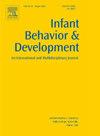Early influence of language experience in non-native speech perception: Discrimination of three-way Thai stop contrasts by Korean and Japanese infants
IF 1.9
3区 心理学
Q3 PSYCHOLOGY, DEVELOPMENTAL
引用次数: 0
Abstract
Young infants’ remarkable ability to discriminate non-native phoneme contrasts played a critical role in shaping the tenets of the perceptual narrowing hypothesis: early on, infants are sensitive to most phoneme categories, including those not used in their native language, but lose this sensitivity as they attune to their language. However, supporting evidence was derived from limited geographical regions and languages, particularly on early sensitivity, requiring further studies to specify the extent of early sensitivity and reassess the dominant developmental pattern. This study aimed to fill this gap by examining discrimination patterns for three-way Thai stop contrasts by two other Asian language learners (Korean and Japanese) at age 4–6 months. The three stop categories in Thai are distinct along the voice onset time (VOT) dimension, encompassing both negative and positive values. Thai pre-voiced and voiceless (i.e., short lag) stops are similar to stop categories used in languages such as French, Dutch, and Spanish. Thai voiceless and voiceless aspirated (i.e., long lag) stops are similar to those in English, Chinese, and German. Therefore, Thai stop categories provide an ideal test continuum for confirming early universal sensitivities to two supposedly language-general VOT boundaries (−30 ms, +30 ms). We presented two Thai phoneme pairs (pre-voiced vs. voiceless, voiceless vs. voiceless aspirated) to Korean and Japanese infants aged 4–6 months and observed their discrimination patterns using a visual habituation paradigm. The results showed divergent discrimination between the two language learners. Korean infants showed sensitivity to the pre-voiced–voiceless pair, whereas Japanese infants did not. By contrast, only Japanese infants showed some sensitivity to the voiceless–voiceless aspirated pair with some directionality effect, whereas Korean infants did not. These results demonstrate systematic cross-linguistic differences reflecting input influence in early perceptual sensitivity and suggest the ambient language environment may influence consonant perception much earlier than has been considered by the perceptual narrowing theory, calling for further refinement of the extent of initial perceptual state in the theory.
语言经验对非母语言语知觉的早期影响:日韩婴儿对泰式三音停顿对比的辨析。
幼儿区分非母语音素对比的卓越能力在形成感知缩小假说的原则方面发挥了关键作用:早期,婴儿对大多数音素类别都很敏感,包括那些不在母语中使用的音素类别,但随着他们与语言的协调,这种敏感性就会丧失。然而,支持证据来自有限的地理区域和语言,特别是在早期敏感性方面,需要进一步研究以明确早期敏感性的程度并重新评估主要的发展模式。本研究旨在通过研究另外两个亚洲语言学习者(韩国和日本)在4-6个月大时对泰式三音停顿对比的歧视模式来填补这一空白。泰语的三种停顿类别在语音开始时间(VOT)维度上是不同的,包括消极和积极的值。泰语的前置浊音和不浊音(即短滞后)停顿与法语、荷兰语和西班牙语等语言的停顿类别相似。泰语的不发音和不发音的送气停顿(即长滞后)与英语、汉语和德语中的停顿相似。因此,泰语停止类别提供了一个理想的测试连续体,用于确认对两个假定的语言通用VOT边界(-30毫秒,+30毫秒)的早期普遍敏感性。我们向4-6个月大的韩国和日本婴儿展示了两个泰国语音素对(预发声与不发声,不发声与不送气),并使用视觉习惯范式观察了他们的识别模式。结果显示,这两个语言学习者的辨别能力存在差异。韩国婴儿对前发声和无发声的组合表现出敏感,而日本婴儿则没有。相比之下,只有日本婴儿对不发音-不发音吸气对表现出一定的敏感性和方向性效应,而韩国婴儿则没有。这些结果显示了系统的跨语言差异,反映了早期感知敏感性的输入影响,并表明周围语言环境可能比感知缩小理论所考虑的更早地影响辅音感知,需要进一步完善理论中初始感知状态的程度。
本文章由计算机程序翻译,如有差异,请以英文原文为准。
求助全文
约1分钟内获得全文
求助全文
来源期刊

Infant Behavior & Development
PSYCHOLOGY, DEVELOPMENTAL-
CiteScore
4.10
自引率
4.80%
发文量
94
期刊介绍:
Infant Behavior & Development publishes empirical (fundamental and clinical), theoretical, methodological and review papers. Brief reports dealing with behavioral development during infancy (up to 3 years) will also be considered. Papers of an inter- and multidisciplinary nature, for example neuroscience, non-linear dynamics and modelling approaches, are particularly encouraged. Areas covered by the journal include cognitive development, emotional development, perception, perception-action coupling, motor development and socialisation.
 求助内容:
求助内容: 应助结果提醒方式:
应助结果提醒方式:


